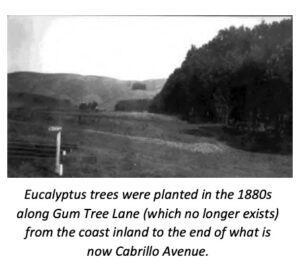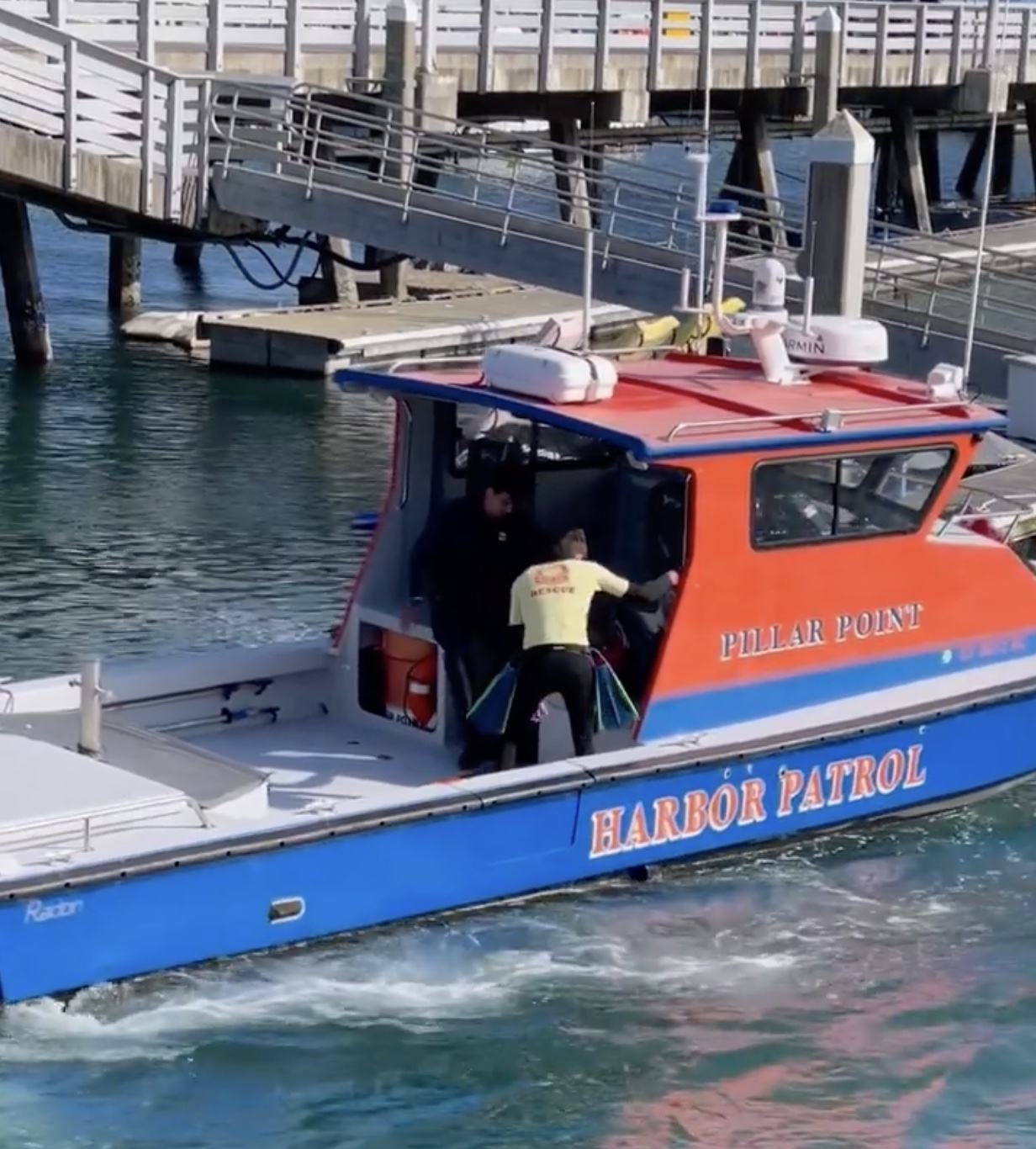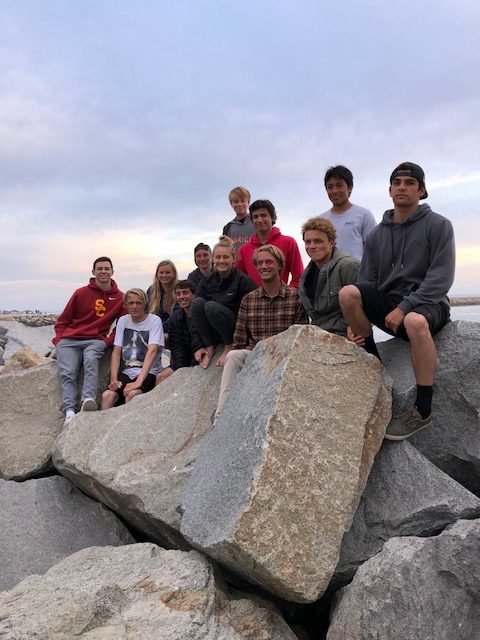|
Getting your Trinity Audio player ready...
|
 OWN VOICE. ~ InPerspective by Gregg Dieguez —
OWN VOICE. ~ InPerspective by Gregg Dieguez —
There’s a tension in El Granada over the removal of eucalyptus trees for wildfire risk reduction – at least in the medians. Here are some arguments on both sides.
Footnotes: to use, click the bracketed number and then click your browser Back button to return to the text where you were reading.
Images: Click to enlarge for improved readability in a new window.
There are a group of environmentally conscious residents in El Granada (El Granada Advocates — [email protected]) pushing to retain eucalyptus in the medians. Their concerns stem in part from the aesthetic shock from the half million $$$ removal of eucalyptus performed last year as part of a fuel reduction strategy, and in part from the (potentially unintended) environmental consequences they forsee from removal of those trees. Their report “A Review of Potential Environmental Consequences of Coastal Tree Removal In El Granada“ was submitted to the MCC [click that link to review]. There is much to agree with in their analysis:
- Require adequate environmental reviews before tree removal and re-vegetation
- Changes to something as complex as an environment ecosystem should be made gradually
- Initial focus and expenditure should be on the areas of greatest risk, with the greatest payback
- The homes are also the fuel, not just the trees.
- The expenditure of half a million was responsive on the part of the County, but may have been an inefficient use of funds, in part due to County procurement practices.
On some matters, however, I disagree with their analysis.
A. My research found that eucalyptus are among the most flammable trees in the world[1]. Several articles here[2], and several meetings at the MCC with CalFire have spoken to the huge issue they represent. I don’t find that in dispute, in spite of the claims in their analysis.
B. I do agree we risk saltwater intrusion here Coastside, but my first solution would be to cap the wells and rely on CCWD supplies, not to retain eucalyptus.
C. Eucalyptus trees are thirsty. They soak up a lot of water. It’s not clear they help retain it in the soil as much as other trees with larger root systems and less thirst[3]. Eucalyptus leaves, once on the soil actually prevent native plants from germinating (prevention of native plant growth is the exact opposite of what we want). I’m tempted to say “Any tree, as long as it’s not Eucalyptus”.
My overriding concerns are twofold. First, do firebreaks even work for wind-borne fires? Certainly, the wide avenues in El Granada would be a pretty wide fire break, if they had no trees. However, there’s evidence such breaks do not work. Second, are stands of eucalyptus on the medians serving as wind-breaks helping to retard fire, or are they a fire-catching ‘bridge’ allowing a canopy fire to leap from area to area? If the latter, a program to remove the extremely flammable eucalyptus should be part of an effective mitigation strategy. In the event of Diablo winds from the East, the medians in EG – downhill and to the West – will do nothing to slow those winds – already recorded at 40-60MPH by local residents. Finally, if trees are a desirable wind-break, atop all their other aesthetic and environmental benefits (moisture retention, cooling, etc.), why can’t they be redwood or oak or some species which is much more fire-tolerant?
Another issue cited by [email protected] is the loss of home value from losing the tree aesthetic. And I agree, it would be an impact if we did not re-vegetate. However, my first priority would be making sure we HAVE homes, then about aesthetics.
Certainly the 250 petition signers this group gathered indicates a shared sentiment in favor of trees. However, it is far less than the 600 signatures gathered opposing eucalyptus. Probably some people signed both petitions. And I suggest there’s room for a solution both groups can accept. I certainly share resident appreciation for the beauty and environmental services trees provide. I believe re-vegetation (“replace trees with trees”) is a necessary component of a fuel management solution in El Granada. However, I think we need an expert review of alternatives before deciding to retain flammable eucalyptus as the featured tree species in El Granada. I see the benefits and risks from a tree canopy, but my concern is that it shouldn’t be eucalyptus.
FOOTNOTES:
[1] Flammability of Eucalyptus, especially Globulus, our kind…
Leaf Thermal and Chemical Properties as Natural Drivers of Plant Flammability of Native and Exotic Tree Species of the Valparaíso Region, Chile
[2] Articles on Eucalyptus and Wildfire Risks:
https://www.coastsidebuzz.com/down-with-eucalyptus/
https://www.coastsidebuzz.com/hanging-fire-eucalyptus-crown-fires-and-el-granada/
https://www.coastsidebuzz.com/the-root-of-the-problem/
https://www.coastsidebuzz.com/wildfire-half-measures-better-than-none/
https://www.coastsidebuzz.com/fighting-the-wrong-fire/
https://www.coastsidebuzz.com/the-fire-next-time/
[3] Eucalyptus effect on soil hydrology
First, an anecdote from a longtime resident, then the technical details:
“Back in the 90’s there was resident concern about the perennial stream that had dried up at the south west side of Quarry Park. People suspected it was another JL Johnson plot to enable home building in a wetland. A group of us walked the former stream area and it was obvious that there was no hidden drainage there. The eucalyptus had effectively hijacked the stream. The eucalyptus alteration of the wetlands is probably a much greater problem now that we no longer have the coastal fog to replenish groundwater during the summer..”
Stands of mature eucalyptus have been associated with altering local hydrology. The hydrophic nature of the leaf litter has been shown to increase soil water repellency (Thompson, et al., Ferreira et al., 2000). The result is an increase in surface water runoff, higher rates of erosion and sedimentation, and a decrease in groundwater recharge. Eucalyptus trees show high rates of evapotranspiration, extracting water at great depths and under dry conditions (Bell and Williams, 1997, Pryor, 1976)
Eucalyptus depletes the the nutrients and moisture reserves of the soil and inhibits the undergrowth due to allelopathic properties (Note: many plants have these properties to ‘defend their turf’). Furthermore the decomposition of the dead plant parts is very slow which adversely affects the nutrient cycling. Owing to these adverse effects, Eucalyptus is often referred as “Ecological Terrorist”. Please check these links and PDF attachments for more details.
1) Eucalyptus_invasions_in_riparian_forests…
2) Allelopathic_effects_of_Eucalyptus
3) http://www.hindawi.com/journals/ijfr/2013/463030/
4) http://www.ncbi.nlm.nih.gov/pubmed/19899483
5) Eucalyptus invasions in riparian forests: Effects on native …
6) Allelopathic effects of Eucalyptus (Eucalyptus Camldulensis …
More From Gregg Dieguez ~ InPerspective
Mr. Dieguez is a native San Franciscan, longtime San Mateo County resident, and semi-retired entrepreneur who causes occasional controversy on the Coastside. He is a member of the MCC, but his opinions here are his own, and not those of the Council. In 2003 he co-founded MIT’s Clean Tech Program here in NorCal, which became MIT’s largest alumni speaker program. He lives in Montara. He loves a productive dialog in search of shared understanding.







I too understand the fear of fire, especially if one hikes into Quarry Park. The underbrush is thick and the trees dense. Years of neglect have made this possible. Until this problem is completely addressed in the Quarry and surrounding area, the danger remains. The question is, what can the county do about it with limited funds? It seems logical that the funds should be used in the highest risk areas. Reduce the fire fuel above El Granada rather than focusing in the town itself.
The Focus on the High Risk Wildfire Zones Petition asks that the funds be used in the highest risk areas. The petition requests the following:
You can read in full detail here: https://tinyurl.com/El-Granada-Advocates
Please consider signing this petition for fire protection funds to be used in the best way possible in the El Granada area.
We all fearful of fire in our towns for very valid reasons. But we can’t let that fear drive our fire mitigation strategies. In my personal opinion, it is over-reactive and fear based to use the approach of eradicating all the Eucalyptus in the lower risk zones or cutting all the trees down around us to save ourselves. Yes, some are high risk and need to be removed, but we don’t need to cut down our 120 year plus Eucalyptus tree-lined streets or our Eucalyptus Park-Lets (which capture so much carbon and cool our climate). We need a balanced strategy with nature-based solutions. Fire has always been part of the land and suppression of it has created this mess. We can use prescribed seasonal burns, forest grazing, greenbelts, cutting firebreaks or shaded fuel breaks (which have saved many towns). If the all the trees were removed on the medians, guess where embers from a wildfire could land? Still on the homes. It’s not a solution. The 600+ petition Quarry Park Threat petition is not about cutting the tree medians down according to the wording. That was about Quarry Park, so please don’t compare the two. The two petitions actually support each other regarding firebreaks. If we could restore the medians with native trees that could capture as much carbon as those median trees, we should do it, but it would take 100+ years to replace the carbon capture these old trees provide. And, median restoration is not likely due to County legal issues. The Focus on the High Risk Wildfire Zones Petition asks to have the medians maintained for safety and assessed regularly.
After receiving feedback from the authors of that paper, I changed the terminology for that group to “El Granada Advocates”. That title did not appear in their paper, but the correction comes from people I know to be involved in the group.
Thanks Gregg
Gregg, the email address you have listed in this article for El Granada Advocates is still incorrect. The correct address is: [email protected]
Thank you.
Check out the Petition for Focus on The High Wildfire Risk Zones, El Granada, CA and consider signing! https://tinyurl.com/El-Granada-Advocates
Re-plant with California native tress.
Gregg,
As usual a very informative and thoughtful article. I do however have to comment that fire breaks do work, as evidenced by the dynamiting of Van Ness Avenue to prevent the further spread of fires caused by the San Francisco April 18th, 1906 earthquake. The earthquake broke all the water mains and as buildings were damaged there was no way to stop the fires. Here is a link: http://www.sfmuseum.org/1906/Coleman.html
Very balanced and well said. We’re all in this together.